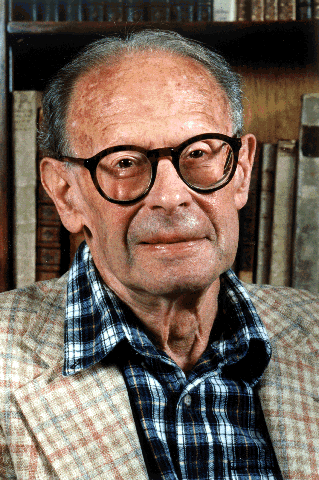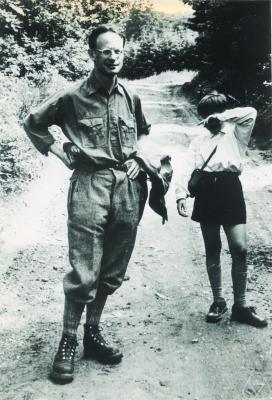<Back to Index>
- Mathematician André Weil, 1906
- Author Gaston Louis Alfred Leroux, 1868
- President of the Indian National Congress Motilal Nehru, 1861
PAGE SPONSOR


André Weil (6 May 1906 – 6 August 1998) was an influential mathematician of the 20th century, renowned for the breadth and quality of his research output, its influence on future work, and the elegance of his exposition. He is especially known for his foundational work in number theory and algebraic geometry. He was a founding member and the de facto early leader of the influential Bourbaki group. The philosopher Simone Weil was his sister.
Born in Paris to Alsatian agnostic Jewish parents who fled the annexation of Alsace-Lorraine to Germany, Weil studied in Paris, Rome and Göttingen and received his doctorate in 1928. While in Germany, he befriended Carl Ludwig Siegel. He spent two academic years at Aligarh Muslim University from 1930. Hinduism and Sanskrit literature were his life-long interests. After one year in Marseille, he taught six years in Strasbourg. He married Éveline in 1937.
Weil was in Finland when World War II broke out; he had been traveling in Scandinavia since April 1939. Éveline returned to France without him. Weil was mistakenly arrested in Finland at the outbreak of the Winter War suspected of spying; however, accounts of his life having been at danger have been shown to be exaggerated. Weil returned to France via Sweden and the United Kingdom, and was detained at Le Havre in January 1940. He was charged with failure to report for duty, and was imprisoned in Le Havre and then Rouen. It was in the military prison in Bonne-Nouvelle, a district of Rouen, from February to May, that he did the work that made his reputation. He was tried on 3 May 1940. Sentenced to five years, he asked to be sent to a military unit instead, and joined a regiment in Cherbourg. After the fall of France, he met up with his family in Marseille, where he arrived by sea. He then went to Clermont-Ferrand, where he managed to join Éveline, who had been in German-occupied France.
In
January 1941, Weil and his family sailed from Marseille to New York. He spent the
war in the United States, where he was supported by the Rockefeller
Foundation and Guggenheim
Foundation. For two years, he unhappily taught undergraduate
mathematics at Lehigh
University. He taught at the Universidade
de
São Paulo, 1945–47, where he worked with Oscar
Zariski. He taught at the University
of
Chicago from
1947 to 1958, before spending the remainder of his career at the Institute
for Advanced Study. In 1979, he shared the second Wolf
Prize
in Mathematics. He made
substantial contributions in many areas, the most important being his
discovery of profound connections between algebraic geometry and number
theory. This began in his doctoral work leading to the Mordell–Weil
theorem (1928, and
shortly applied in Siegel's
theorem
on integral points). Mordell's
theorem had an ad hoc proof; Weil began the
separation of the infinite
descent argument
into two types of structural approach, by means of height
functions for
sizing rational points, and by means of Galois
cohomology, which was not to be clearly named as that for two more
decades. Both aspects have steadily developed into substantial theories. Among his
major accomplishments were the 1940 proof, while in prison, of the Riemann
hypothesis for local
zeta-functions, and his subsequent laying of proper foundations for
algebraic geometry to support that result (from 1942 to 1946, most
intensively). By modern standards his claim to have a proof had a very
easy ride, but wartime conditions were one factor, and the fact that
the German experts made little or no comment another. The so-called Weil
conjectures were
hugely influential from around 1950; they were later proved by Bernard
Dwork, Alexander
Grothendieck, Michael
Artin, and Pierre
Deligne, who completed the most difficult step in 1973. He had
introduced the adele
ring in the late
1930s, following Claude
Chevalley's lead with the ideles,
and
given a proof of the Riemann–Roch theorem with them
(a version appeared in his Basic
Number
Theory in
1967). His 'matrix divisor' (vector
bundle avant la lettre) Riemann–Roch theorem from 1938 was a
very early anticipation of later ideas such as moduli spaces of bundles. The Weil
conjecture
on Tamagawa numbers proved
resistant
for many years. Eventually the adelic approach became basic in automorphic
representation theory.
He
picked up another credited Weil
conjecture, around 1967, which later under pressure from Serge
Lang became known
as the Taniyama–Shimura
conjecture based on
the presentation of the basic ideas at the 1955 Nikkō conference. His
attitude towards conjectures struck many in the field as oblique; he
wrote that one should not dignify a guess as a conjecture lightly, and
in the Shimura–Taniyama case, the evidence was only there after
extensive computational work carried out from the late 1960s. Other
significant results were on Pontryagin
duality and differential
geometry. He introduced the concept of uniform
space in general topology. His work on sheaf
theory hardly
appears in his published papers, but correspondence with Henri
Cartan in the late
1940s, and reprinted in his collected papers, proved most influential. He
discovered that the so-called Weil
representation, previously introduced in quantum
mechanics by Irving
Segal and Shale,
gave a contemporary framework for understanding the classical theory of quadratic
forms. This was also a beginning of a substantial development by
others, connecting representation
theory and theta-functions. Weil's
ideas made an important contribution to the writings and seminars of Bourbaki,
before
and after World
War
II. His books had an important influence on research, an
exceptional situation in mathematics. (In one famous case, the
influence was possibly negative: Alexander
Grothendieck is
said to have complained of the 'aridity' of Weil's Foundations of Algebraic
Geometry.) The style of his books is clearly demarcated from that
of his research papers. He
invented the notation "Ø" for the empty
set (q.v.).
Indian
(Hindu)
thought had great influence on Weil. In his autobiography, he
says that the only religious ideas that appealed to him were those to
be found in Hindu philosophical thought. During the second World War,
Weil refused to do military service and cited the Bhagavad
Gita to justify his
stand: he said his true dharma was the pursuit of
mathematics and that was what he should be doing, not assisting in the
war effort, however just the cause.